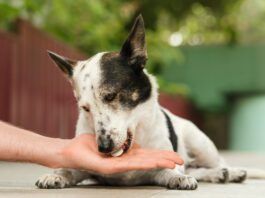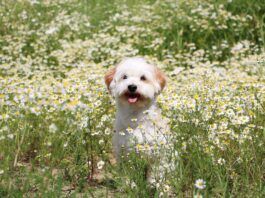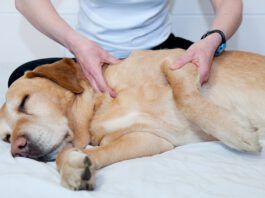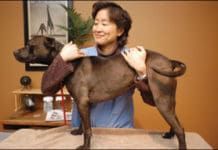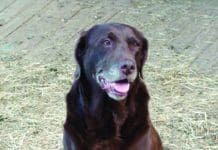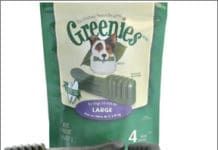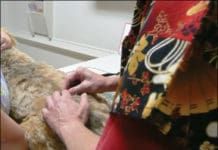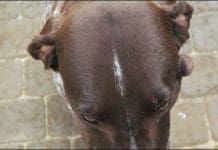Detecting Canine Anal Sac Problems
Anal sacs are located on either side of your dog’s anus, between the external and internal sphincter muscles. Depending on the dog, they range in size from that of pea to a lima bean. Sebaceous glands within the lining secrete a foul-smelling liquid. Under normal circumstances, the sacs empty on their own during bowel movements via a pair of ducts. This natural, routine emptying serves as a means of olfactory communication and establishing territory. Each dog possesses his own unique scent, which is why ritualized dog-to-dog greetings include copious rear-end sniffing. When a dog presents his rear for information gathering, the muscle movements involved in raising the tail apply pressure to the sac, prompting the release of additional scent.
Canine Kidney Stone and Bladder Stone Prevention
just slide a clean dish under your dog as she urinates! You need to catch only a few drops to test.üUrinary tract infections that cause struvite crystals to become uroliths can raise urinary pH to 8.0 or 8.5. Contact your vet if your dog's urinary pH jumps from acid to alkaline.üStruvite (magnesium ammonium phosphate or "triple phosphate") crystals in polarized light (total magnification 112x). Struvite crystals are common in dogs and don't cause problems until they unite to form stones that interfere with urination; generally
Less Stressful Veterinary Visits
A training friend suggested that I read Low Stress Handling, Restraint, and Behavior Modification of Dogs and Cats, by applied animal behaviorist Sophia Yin, DVM, MS. As an owner whose dogs have taken their fair share of visits to vet clinics, I really liked what I read. Dr. Yin's text takes a critical look at how our pets are often handled in veterinary clinics and it's not pretty, as you may have seen yourself. Fortunately, she also offers common sense advice on approaching veterinary care so as to make it as stress-free as possible for our pets. Popular myths abound that force is needed to get animals to behave. Instead, Dr. Yin focuses on how to modify behavior quickly in a veterinary setting using a systematic and positive approach. Her methods involve classical conditioning to change the pet's emotional state; setting up the veterinary environment to ensure the pet's comfort; teaching us how to handle animals with appropriate, rather than stronger, restraint; and how to behave around animals so as to avoid creating problems.
Alternatives to Surgery for Ligament Injuries in Dogs
Dogs go lame for all kinds of reasons. Arthritis, Lyme disease, paw injuries, muscle sprains, bee stings, interdigital dermatitis, and dislocated kneecaps can make any dog limp. But when an active dog suddenly can't put weight on a hind leg, the most common diagnosis for more than a million American dogs every year is a torn cruciate ligament. In 2003, according to the Journal of the American Veterinary Medical Association, the cost of treating those injuries exceeded $1.32 billion, and the price tag keeps rising. The most common prescription for canine knee injuries is surgery. Unfortunately, operations don't always work and some patients, because of age or other conditions, are not good candidates. In recent years a nonsurgical approach called conservative management" has helped thousands of dogs recover from ligament injuries
Acupuncture For Dogs With Cancer
without any hesitation
The Benefits of Rehabilitation Therapy for Dogs
About a decade ago, my then-young Bouvier, Jolie, had surgery to repair a herniated disc. From reading Whole Dog Journal, I was vaguely aware that veterinary physical therapy or rehabilitation existed; these specialties were mentioned in Recovery From a Fetch Injury" in the August 1999 issue
Helping Your Dog Lose Weight
When Ella, a five-year-old Norwich Terrier, first came to live with me a few months ago, she weighed a svelte 10.8 pounds. But within two months her weight had ballooned by almost a full pound, and there was no way you could call her anything but plump. How could this happen? How could I have let my new dog get fat me, the one who perpetually preaches the benefits of keeping dogs lean? And what the heck was I going to do about it? The answer is that it happened because Id never owned such a small dog before, and it turned out I was massively overfeeding her, particularly when I counted all the treats she was getting. And I would do whatever it takes to get her back to the weight she should be, and keep her there. Here is what I learned during my struggle to help Ella lose weight.
Canine Health News You Can Use
In June, Virbac recalled VeggieDent Chews for Dogs in Australia as a precautionary measure after veterinary researchers noticed a possible link between dogs developing kidney disease and consumption of these chews. No reason has been found and there is as yet no proof that the chews are causing the Fanconi-like syndrome. The chews were introduced to Australia in March of this year. They are manufactured in Vietnam, and are made of corn, starch, glycerin, soy, rice, yeast, sorbitol, corn derivatives, and water. VeggieDent chews have been marketed in the U.S. since September 2008, and in Europe and Japan for two years, but Virbac claims it has not received reports of problems anywhere except Australia – the only country that required some imported pet foods to be irradiated. Virbac blames the irradiation for the problem.
Hemorrhagic Gastroenteritis in Dogs
The symptoms came on fast and furious. One day Chloe was a healthy, tail-wagging Labrador Retriever and the next day she was vomiting mucus all over the house. Then her vomit turned red with blood and then came matching diarrhea. Chloe had hemorrhagic gastroenteritis, or HGE. Hemorrhagic gastroenteritis is a mystery disease. No one knows what causes it and there is no recommended prevention. It does not seem to be contagious from one dog to another, although dogs living together sometimes develop HGE at the same time, and some parts of the country have reported outbreaks of several cases. It's most dangerous for small dogs, and although some veterinarians consider toy and miniature breeds between the ages of two and four the most typical HGE patients, males and females of all breeds and ages have been affected. There are few, if any, HGE warning signs. It is not usually accompanied by a fever. Diarrhea containing bright or dark red blood is the illness's signature symptom. Vomiting, which usually accompanies the diarrhea, typically begins as mucus or bile and then becomes bloody. Affected dogs may eat grass and vomit that as well.
Probiotics and Dogs
Curly, a five-year-old Standard Poodle, eats the best food his human can afford. Raw chicken, rabbit, and venison are his favorites. Tina, his two-legged companion, switches the meats every few days, mixing the protein with some sweet potato, carrots, an occasional stalk of broccoli, and always a good fish oil supplement. Plus, to be sure that Curly is getting full nutritional benefit from every delicious bite, Tina always adds a sprinkling of a probiotic and digestive enzyme supplement as a final touch. Everything Curly eats is the best of the best: human-grade ingredients, no preservatives, no by-products. But somehow, despite all of the good lovin' and great food, Curly is a bit thin, won't put on weight, and his stool is sometimes dry making it hard for the poor guy to poop during his daily walks. Tina knows that something is amiss and she is worried. She was told that maybe the probiotics weren't active, so she tried several different brands. But nothing has improved. So what gives; is it that the probiotics don't work? Adding supplemental Lactobacillus acidophilus, Bifidobacterium bifidum, Lactobacillus bulgaricus, or other probiotic organisms to your dog's diet is almost always a good idea. This will support the resident microflora that are always present in Curly's gut, enhancing digestion and absorption of nutrients, supporting detoxification and elimination processes, and helping to boost his immune system.
Canine Swimming Lessons: The Perfect Exercise For Your Dog
For those of us who regularly swim for fitness, we know why swimming is often referred to as “the perfect exercise.” In addition to the physical benefits shared with other forms of aerobic exercise, swimming offers some unique benefits. It eliminates the effects of weight-bearing on the joints, exercises the entire body – upper and lower – at the same time, and, in most cases, is something we can do for our entire lives, even if age precludes us from taking part in other forms of exercise. The physical benefits of swimming are the same for your canine companion as they are for you – that is, if you have a dog who will swim. Even though they actually have a stroke named after them, the notion that all dogs are “natural swimmers” is an erroneous one. Some breeds were developed to work in water and are more physically adapted for swimming than others. The problem here is not getting these dogs into the water, but keeping them on terra firma when we want them to stay clean and dry. However, occasionally, even a water breed shows disdain for water – yes, there are some Labrador Retrievers who hate swimming. Conversely, there are dogs you’d never imagine taking kindly to the water who become devoted and skilled swimmers. Although not blessed with the physical advantages of a water breed, and despite sinking rear ends or heavy, wet coats, these Boston Terriers, Rhodesian Ridgebacks, and Siberian Huskies have learned to enjoy swimming. They don’t know or care that they have to work a little harder than a Poodle, Cocker Spaniel, or a Newfoundland – they just want to have fun!



